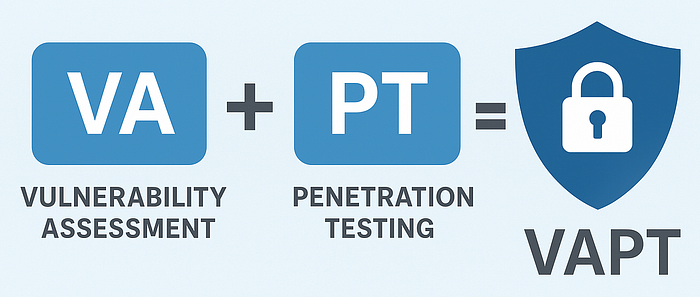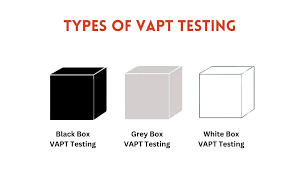Disclaimer: If you are really interested in VAPT, take the next 5 minutes to read this blog fully. Remember, experienced pentesters started from zero too! They spent countless hours learning, practicing, failing, and improving. So give your best effort and you will get what you want. Follow for more VAPT guides! 🚀
Welcome to VAPTify👋
Hello Everyone! Welcome to VAPTify — your space to learn Vulnerability Assessment and Penetration Testing (VAPT) from Beginners to Advanced. I have around 2 years of experience in VAPT across Web, Mobile, API, Network, and Cloud.
Here, we will go step by step, sharing how I started VAPT and how you can start too. Whether you are curious about finding vulnerabilities or securing systems ethically, this blog is for you. You will learn the basics first, then gradually move to advanced topics. 🔒

What is VAPT? 🤔

Vulnerability Assessment (VA) ⚠️
VA is the process of identifying, quantifying, and prioritizing vulnerabilities in a system. It helps you know what is weak or exposed. For example, a website may have an outdated WordPress version or open ports that are risky. VA gives you a clear map of these vulnerabilities before anyone attacks
(Basic: Nothing but VA is to identify vulnerable endpoints without exploit).
Penetration Testing (PT) 🕵️♂️
PT is the process of simulating real-world attacks to exploit the weaknesses. It tells you how an attacker could break in. For example, if the endpoint is vulnerable to SQL injection is VA, but testing if a SQL injection can retrieve user data or exploiting misconfigured cloud storage will provide the exploitation is PT. Together with VA, PT ensures the system is truly secure.
(Basic: Nothing but PT is to identify the vulnerable endpoint & exploit the vulnerability to find how attacker can able to compromise it.)
Types of Testing in VAPT 🧪
There are three main types of testing based on knowledge access:

1️⃣ Black Box Testing 🌐
Explanation: The tester has no prior knowledge of the system. Testing is done from the perspective of an outsider or hacker.
VA Tasks 🛠️: Scan for open ports, running services, outdated software, and misconfigurations. Example: Using Nmap to discover open ports and versions on a target web server.
PT Tasks 🔓: Attempt to exploit vulnerabilities like SQL injection, XSS, or weak passwords. Example: Trying a login bypass using SQLi payloads on a form without knowing the backend code.
2️⃣ White Box Testing 🏗️
Explanation: The tester has full knowledge of the system, including code, architecture, and configs. This is deep internal testing with provided details.
VA Tasks ✅: Review code, logs, and configuration files to find vulnerabilities. Example: Checking API keys or hard-coded credentials in a source code repository.
PT Tasks 🎯: Use internal knowledge to perform targeted attacks. Example: Exploiting a misconfigured API endpoint discovered in the code to access sensitive data.
3️⃣ Grey Box Testing ⚖️
Explanation: The tester has partial knowledge of the system, such as credentials or limited system details. It's a combination of Black & White Box.
VA Tasks 🔍: Identify vulnerabilities with partial access like a legitimate user. Example: Testing a user account for privilege escalation possibilities.
PT Tasks 🧩: Exploit vulnerabilities using the limited info, simulating insider threats. Example: Using a valid login to access admin functions that shouldn't be allowed.
Why Do VAPT? 💡
We are living in a internet world 🌎. Any asset connected to the internet — whether a web application, mobile app, API, network router, cloud service, smart TV, or IoT device — can be attacked.
VAPT helps to:
- Identify weaknesses before attackers do. 🕵️♂️
- Prevent data breaches, financial loss, or reputational damage. 💸
- Ensure regulatory compliance and build customer trust. ✅
- Continuously improve the security posture of your systems. 🔐
Example: A smart TV connected to the internet may have an outdated firmware. VAPT can detect it, and PT can simulate an attack to demonstrate the risk, helping the manufacturer fix it.
Simply put, if it's connected, it's at risk. VAPT is your shield! 🛡️
Different Scopes in VAPT 🌐

VAPT is not just for websites. Here are different kind of testings:
- Web Applications 🌐
- Mobile Applications 📱
- API Security ⚙️
- Network Security 🖧
- Cloud Security ☁️
- Thick Client Applications 💻
- IoT Devices 🏠📡
Tip: Choose your path wisely. Start with what interests you and gradually expand. For beginners, I recommend starting with Web Application Security, then moving to API and Network.
Let's Get Started with Web VAPT ✅
What is Web VAPT?
Web VAPT is the process of finding vulnerabilities in websites and web applications. It includes testing login forms, APIs, session management, file uploads, and more. The goal is to detect weaknesses and help developers fix them before attackers exploit them.
Example: Testing a contact form for SQL Injection or checking file upload functionality for malware upload risk.
Follow for the next blog where we will deep dive into Web Application Security Assessment step by step. 🌐🔍
Follow VAPTify for more beginner to advanced VAPT tutorials! 🔒
Share your thoughts on comments to improve us:)


